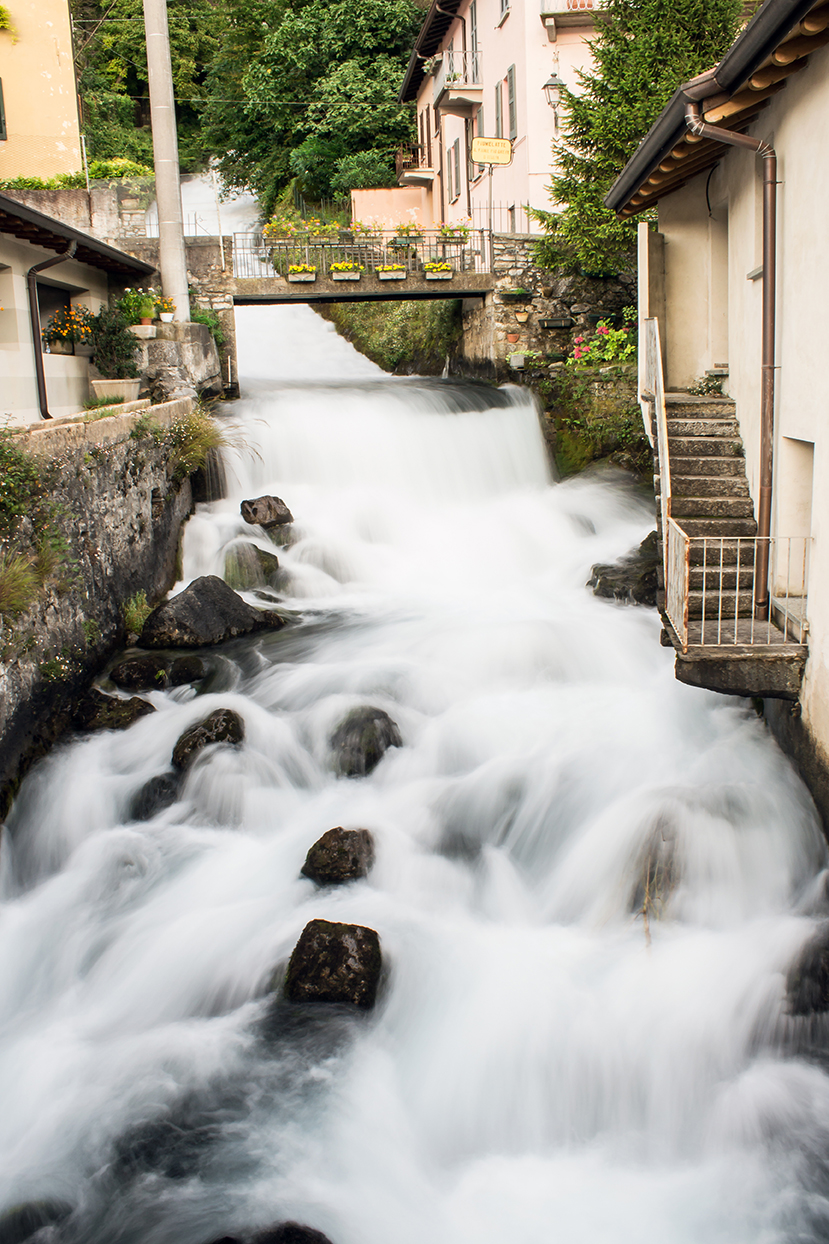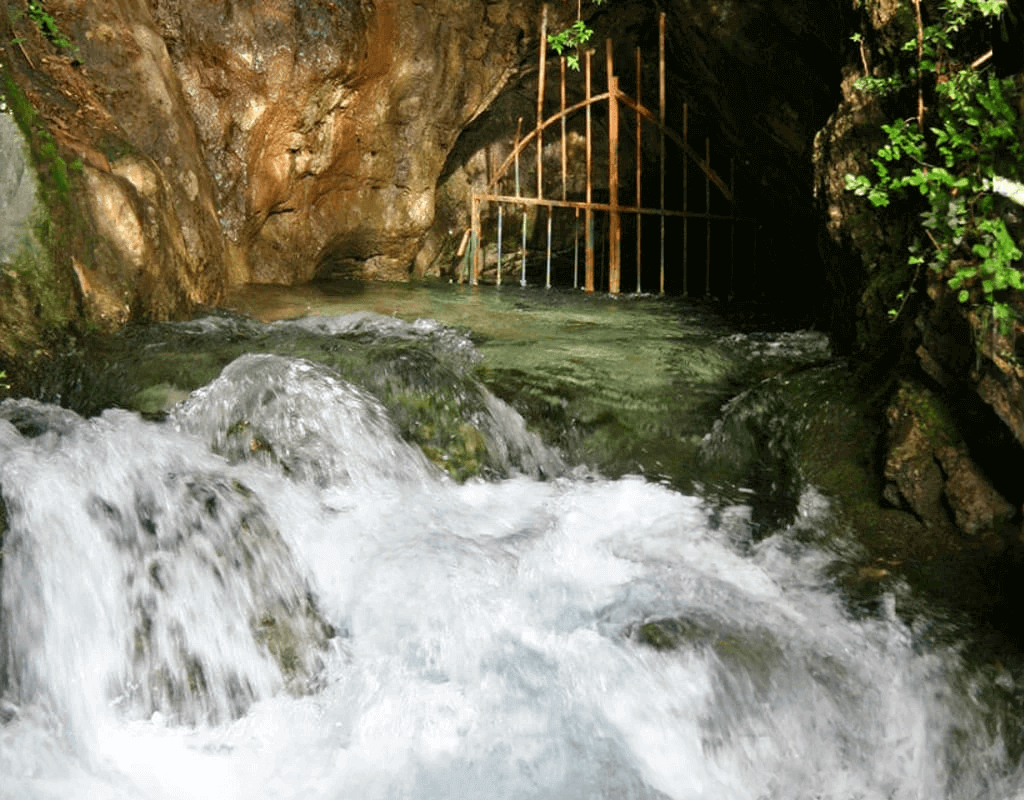Visiting the Fiumelatte Caves
Visiting the Fiumelatte Caves, Varenna, Lake Como
Town: Fiumelatte of Varenna
Limestone Area: Northern Grigna
Entrance: at m. 335 above sea level.
Inside gradient: from +58 to -61 metres
Total Development: m. 740
Visiting the Fiumelatte Caves, Varenna, Lake Como. The cave has three entrances. The lower one (which is the main entrance) is closed by the gate of the aqueduct from where the stream violently gushes out during some periods of the year and, in those periods, the access is forbidden. The second entrance opens about 12 meters higher to the left of the main entrance, but it is walled. The third entrance opens even more to the left than the second and it is reachable through a trace of a path which starts at the left or the main entrance.
Anyway, the entrance is very small (cm. 40 x cm. 60) and it is hidden by the spontaneous vegetation, therefore it is difficult to spot.
Nevertheless, in summer, from it comes out a strong current of fresh air which makes the nearby bushes wave, so signalling its position. When the stream flows inside the cave, it is impossible to visit the cavern in its whole. It is therefore better to visit it in February of during long periods of drought. The cave is a maze of tunnels, placed at different levels, in which sometimes it is difficult to find the right way. The morphology of these caves has the typical characteristic of the cavern with a high water activity.
The River Fiumelatte - Milky river - is famous for the shortness of its flow, only 25o meters. It owes its name to the colour of its water, which are as white as milk because of the violence wit which it springs out from the mountains.

It is a tributary of Lake Como and originates on the Mountain Group of the Grigne.
A peculiarity of this river is the regular intermittence of its flowing which starts from 25th March (festivity of the Annunciation) and it ends the 7 of 8 October (festivity of Our Lady of the Rosary and patron of Varenna), a peculiarity which gave it the nickname of the River of the Two Madonna. The flowing intermittence is due to the fact that Fiumelatte is the overflow of a limestone system of tubs that nobody has till now explored and which starts under the Mountain Moncodeno otherwise called Grignone.
Leonardo da Vinci was attracted by the peculiarity of this phenomenon and in its Atlantic Code he described it in this way:
It is Fiumelaccio, which falls 100 arms higher than the vein from where it is born, from which it crashes down into le lake with inestimable uproar and noise.” Some other important people have written about it, such as Plinii the Elder, Benedetto Giovio and Lazzaro Spallanzani.
In the past centuries, Fiumelatte was a great attraction for tourists and voyagers who described it on their travel notebooks. Peculiar is the note written by Antoine Claude Pasquin (nicknamed Valery), who visited the cave in 1827.
He writes:
The stream Fiume Latte (Milky river), which flows into the lake and gives its name to the village at its feet, makes me remember of the Waterfall Pissevache, near Martigny. The approach I make of these two folk metaphors is because they give the same effect, but they show the difference of the Italian genius and, if it is possible to say, of the Swiss genius. In the same way that sometimes mountains may be good for studying of costumes and spirit of the Nations”.
The mysteries of the Caves of Fiumelatte.
Centuries ago, caverns were thought to be the entrance to the world of the dead (Odyssey - Eneide) and, at the best, they were seen as swallowing holes in which everything could happen. These considerations were for the normal caverns. We can only imagine how one could feel if all of a sudden, at the beginning of Spring, a violent gush of water sprung out from a sombre cave to then as much suddenly stop flowing at the beginning of Autumn.
This mystery must have arisen much curiosity and awe and it is therefore natural that people wanted to understand the nature of that phenomenon. It is inscribed in the mind of men to explore and study the mysteries of nature, but for the Caves of Fiumelatte it has never been easy to get into it. As a matter of facts, when the stream flows in such a violent way, it is impossible to enter into cave.
It was only in 1983 that a group of speleologists of the C.A.I of Lecco were able to overcome some very difficult hindrances and open a way to the cave, founding themselves into a very wide and intricate subterranean environment with such narrow pass-through that forbade them further explorations.
Anyway, four years later, the same Group of Lecco, together with some Swiss speleologists, were able overpass a narrow passage and to draw the topography of one of the descendent siphon. They also guessed that the mysterious intermittent spring ha to be under the under the limestone mountains of Mount Grignone (Moncodeno) at a very deep hypogeum level. That notwithstanding, it has still to be found the cavern of the very source of the stream and the very cause of its intermittence.
In 1992 scientist made an experiment by employing a florescent no toxic colour to verify its distribution and in that way it was possible to demonstrate a connection between Fiumelatte and the limestone caves underneath Mount Grignone. This hypogeal labyrinth cave showed to the speleologists clear sign of hydro activity and it is thought that when the deep underground receiving tub (not yet detected) is too full, the exceeding water outflows causing the tumultuous starting point of the stream that gushes out from the grotto from where it impetuously flows down, fall after fall, to the lake.

The Legend.
In the past times, many legends flourished about this grottos, because it was said that those who entered into it never returned, or those who managed to come out of it, did not survive because of the fright they had to face while inside, or again, he who entered in a dry cave, was suddenly overwhelmed and taken away by the violent waters of the stream, as if they did not want their obscure source being violated.
As a matter of facts, the grotto is a particularly fascinating environment not only from the naturalistic point of view, but also because it gave way to a number of legends. The most popular among them goes back to the 1500. it tell the story of three young men who fell in love with the sale maiden who, not being able to chose among them who to marry, she told them that she would have marred the one who would find the source of Fiumelatte.
Although unwillingly, the three young men decided to accept the challenge and entered the mysterious cavern from where they returned after many months, suddenly looking hundreds and hundreds years older, and they were hallucinated by visions of beautiful mermaids. The first two who came out of the cavern told of wonderful adventures among magnificent places with beautiful maidens and sweet melodies which abruptly stopped leaving them to roaming among the maze of the cramped caves of the grotto. The third one never spoke anymore as if he had become dumb because of some terrifying vision he had.
No one was ever able figure out what had really happened inside the caves of the souce of the river Fiumelatte because the three young men passed away deliriously.
From that time, nobody dared go further the entrance of the grotto.
Obviously, this fantastic tale inspired many writers and poets among which there is the American romantic poet Lonfellow who used to spend long periods at Cadenabbia at the historic hotel Belle Vue, nowadays called Grand Hotel Cadenabbia.
Read all curiosities